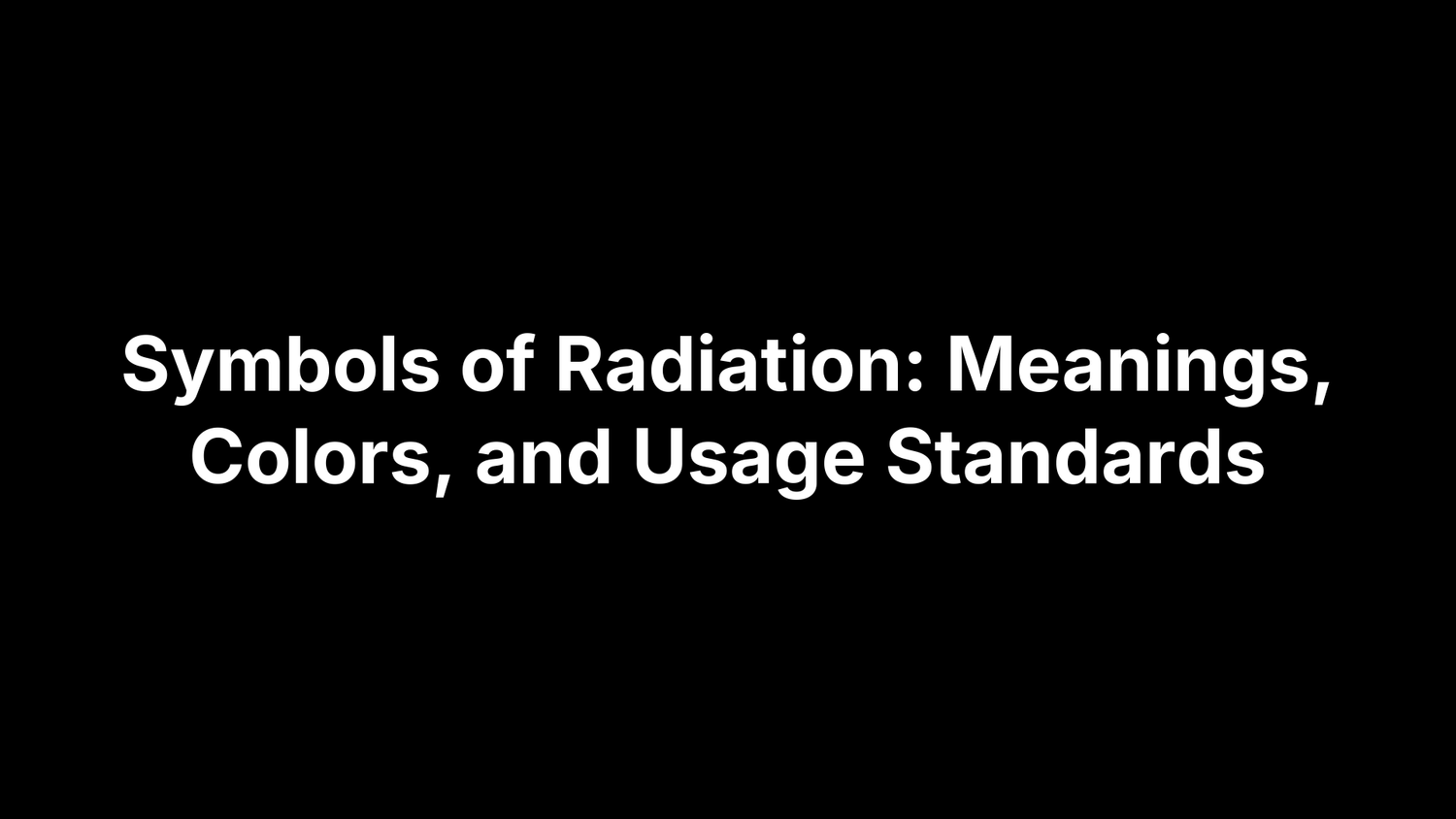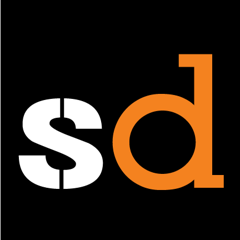Symbols of Radiation: Meanings, Colors, and Usage Standards
Symbols of radiation are standardized pictograms that warn when ionizing or non‑ionizing radiation may be present. The best known is the trefoil—three blades around a center point—printed in magenta or black on yellow. They cue people to slow down, keep distance, use shielding, or avoid contact. Clear, compliant signage reduces risk, prevents accidental exposure, and helps facilities meet regulatory requirements.
This guide explains what each symbol means, how the trefoil evolved, and why color and proportions matter. We cover non‑ionizing symbols (laser, RF/microwave, UV, magnetic fields), when to use the ISO supplementary symbol, and how standards from ISO, ANSI, OSHA, NRC, DOT, and the IAEA apply. You’ll see where these signs belong—including Class 7 transport labels—plus tips for selecting compliant decals.
The ionizing radiation trefoil: meaning, history, and variations
Among symbols of radiation, the trefoil is the best-known warning for ionizing radiation and radioactive materials. Three curved blades around a central dot communicate energy emanating from a source; the IAEA notes the dot represents an atom and the blades the common types of ionizing radiation—alpha, beta, and gamma. Created in 1946 at the University of California Radiation Laboratory (Berkeley), early signs used magenta on blue, but visibility testing drove the shift to yellow backgrounds. By the late 1950s, ANSI codified magenta on yellow; black on yellow became common internationally.
- Meaning: Central “atom” with three blades signaling ionizing radiation emissions (α, β, γ).
- History highlights: Born in 1946 (Berkeley); colors evolved from magenta/blue to magenta/yellow for visibility; standards later fixed proportions and colors.
- Variations you may see: Early designs added wavy or straight arrows; modern standards removed these.
- Not to confuse: The civil defense fallout shelter emblem (circle split into six wedges) is not a radiation hazard symbol.
Standard colors and proportions: magenta or black on yellow
For maximum recognition, standards lock the trefoil’s colors and geometry. In the United States, ANSI established magenta on yellow; internationally, black on yellow is common. The U.S. NRC prescribes “a magenta or black trefoil on a yellow background,” while the IAEA depicts three identical blade segments equidistant around a central circle on yellow. Modern symbols keep a clean silhouette—no arrows or extra graphics—so the warning stays unmistakable at a glance.
- Colors: Magenta on yellow (ANSI/US); black on yellow widely accepted.
- Proportions: Three equal blades, evenly spaced, around a centered circle on yellow.
Who sets the rules for radiation symbols: ISO, ANSI, OSHA, NRC, DOT, and IAEA
Radiation symbols are governed by a network of standards-setters and regulators. ISO formalizes the pictogram globally (ISO 7010 W003), while the IAEA issues safety guidance on correct use across sectors. In the U.S., ANSI codifies sign design conventions, OSHA enforces workplace posting, and the NRC requires the trefoil (magenta or black on yellow) where specified quantities or doses may be present. For transport, DOT rules cover Class 7 labels and placards. Together, they determine what the symbol looks like, where it appears, and how it’s worded.
The supplementary ionizing radiation symbol (ISO 21482): when to use it—and when not to
The ISO 21482 supplementary symbol is a red triangle showing a trefoil, radiation waves, a skull, and a running figure. Created by IAEA/ISO in 2007, it means: Danger—run away—do not touch. It supplements (never replaces) the standard trefoil and is intended as a last‑chance warning on high‑activity sealed sources.
- Use for: high‑activity sealed sources (IAEA Categories 1–3); place under device covers, on internal shields, or on the source housing—visible only during access or dismantling.
- Not for: building entrances or room doors; exterior shipping packages, freight containers, or vehicles; general area signage. It never replaces required trefoil postings.
Symbols for non-ionizing radiation: laser, RF/microwave, UV, and magnetic fields
Not all symbols of radiation indicate ionizing hazards. Facilities also rely on non‑ionizing radiation symbols that flag exposure to concentrated light, radiofrequency energy, ultraviolet light, or powerful magnetic fields. These do not use the trefoil; instead, standardized warning pictograms are used and, for visibility, are typically presented as black symbols on yellow in line with common ISO/ANSI warning formats.
- Laser: Marks areas or equipment where laser beams are present (e.g., surgery suites, cutting/marking cells, research labs). Controls focus on preventing direct or specular beam exposure and ensuring interlocks are active.
- RF/microwave: Identifies exposure zones near transmitters, antenna rooms, or industrial RF sealers/dryers. Maintain safe distances and post status indicators when systems are energized.
- Ultraviolet (UV): Used around UV curing lines, inspection booths, and disinfection cabinets. Protect eyes and skin and prevent viewing of unshielded sources.
- Strong magnetic fields: Common at MRI suites and magnet test bays. Control access, remove ferromagnetic objects, and define a clear perimeter where the field is present even when the system appears idle.
Signal words and legends: when to use Caution, Warning, and Danger
Radiation signs don’t rely on the trefoil alone. In U.S. workplaces, use ANSI-style signal words to indicate severity and add a concise legend that states the hazard, the possible harm, and the required action. Select the signal word after a risk assessment, and keep the message short, consistent, and readable from the expected viewing distance.
- DANGER: Highest severity; immediate, life‑threatening exposure risks. Restrict entry or lock out.
- WARNING: Serious but not imminent hazards in operation or service. Control access and require PPE.
- CAUTION: Lower‑severity or potential exposure. Promote awareness actions (e.g., keep distance, verify shielding).
Where radiation symbols are used: healthcare, industry, research, and public spaces
You’ll find symbols of radiation wherever ionizing or non‑ionizing sources may expose people. Clear postings help clinicians, technicians, and visitors recognize hazards before they enter a room, open a device, or handle a source, and they support regulatory requirements for controlled areas and source custody.
- Healthcare: CT and X‑ray suites, radiotherapy vaults, brachytherapy and nuclear medicine hot labs, and sealed‑source storage.
- Industry: Nuclear gauges on process lines, industrial radiography cameras, and isotope uses in manufacturing and agriculture.
- Research: Isotope labs, source irradiators, accelerators, and instrument enclosures.
- Public spaces: Airport security X‑ray equipment rooms and other controlled screening areas where radiation devices operate.
Shipping and transport markings for radioactive materials (Class 7)
When radioactive material moves on public roads, rails, sea, or air, it falls under Class 7 transport. In the U.S., DOT sets the marking, labeling, and placarding rules for these shipments, while the NRC defines the trefoil as the required radiation warning—an officially prescribed magenta or black trefoil on a yellow background—where specified quantities or doses may be present. Importantly, IAEA/ISO guidance is clear: the ISO 21482 supplementary symbol must not appear on the exterior of shipping packages, freight containers, or conveyances.
- Follow DOT Class 7 rules for package and vehicle markings.
- Use the trefoil hazard symbol where required; magenta or black on yellow (per NRC).
- Never place the ISO 21482 supplementary symbol on external package or vehicle surfaces (IAEA/ISO).
- Ensure symbols of radiation remain clean, unobstructed, and durable against weather and abrasion throughout transit.
Visual guide to common radiation signs and labels
Use this quick visual guide to spot the most common symbols of radiation. Shapes are high‑contrast for fast recognition, with black or magenta graphics on yellow backgrounds, placed on doors, device housings, or packages wherever exposure could occur for people nearby.
- Ionizing trefoil: Magenta or black on yellow; posted on rooms and devices.
- Supplementary ISO 21482: Red triangle; concealed on high‑activity sources under covers.
- Class 7 transport: Trefoil on packages/vehicles; never place ISO 21482 on exteriors.
Common mistakes to avoid with radiation signage
Small deviations can undermine recognition, compliance, and protection. Stick to standardized symbols of radiation and approved placements; avoid ad‑hoc graphics that confuse workers and the public. The pitfalls below show what to watch for before you print, post, or purchase signs and decals.
- Wrong colors or proportions: The trefoil must be magenta or black on yellow with three equal blades.
- Misusing ISO 21482: Don’t place it on doors or on external packages/vehicles; keep it hidden on high‑activity sources.
- Adding arrows or custom artwork: Modern standards require a clean trefoil—no extra graphics.
- Confusing symbols: Never use the fallout shelter emblem as a radiation hazard sign.
- Trefoil for non‑ionizing hazards: Use laser, RF/microwave, UV, or magnetic‑field pictograms instead.
- Missing signal word/legend: Pair the pictogram with a concise, risk‑appropriate message and action.
Sizing, material, and placement best practices for durable compliance
Good signage pairs the right size with rugged materials and smart placement so symbols of radiation stay visible, legible, and compliant over time. Aim for clear reading at the expected viewing distance, preserve the required trefoil colors, and mount where workers and visitors naturally look before entering or servicing equipment.
- Right size: Choose a sign large enough to read from the approach distance; don’t rely on tiny device labels for area warnings.
- Color/contrast: Use the trefoil in magenta or black on yellow; matte finishes cut glare.
- Materials: Specify outdoor‑grade vinyl or polyester, UV‑stable inks, and a protective laminate for abrasion and chemicals.
- Adhesive: Use high‑tack, temperature/chemical‑rated adhesives; edge‑seal in washdown areas.
- Surface prep: Clean/degrease; use adhesion promoters on low‑energy plastics and powder coat.
- Placement: Post at every entrance (eye level), on device access panels/source housings, and on storage—keep lines of sight clear.
- Low light: Consider reflective faces or conspicuity sheeting (e.g., ORALITE) near corridors/exits.
- Maintenance: Inspect routinely; replace if faded, torn, contaminated, or obscured.
How to choose and customize compliant radiation decals for your facility
Start with the hazard, not the artwork. Match the symbol, color, signal word, legend, size, and material to the risk and the environment, then customize for the equipment or area where exposure could occur. Durable construction and precise wording keep your postings compliant and clear over time.
- Use the right pictogram: Trefoil only for ionizing hazards; non‑ionizing get laser/RF/UV/magnet symbols.
- Lock colors/proportions: Magenta or black trefoil on yellow, three equal blades.
- Pick the signal word: Danger/Warning/Caution based on risk assessment; add a concise action‑oriented legend.
- Size for distance: Choose letter height and sign dimensions readable at approach.
- Specify materials: Outdoor‑grade vinyl/polyester, UV‑stable inks, protective laminate; high‑tack adhesive for your surface.
- Plan for conditions: Washdown, chemicals, heat, or low light (add reflective ORALITE sheeting).
- Customize wisely: Add bilingual text, device/room IDs, contact numbers, or inspection fields.
- Leverage experts: Use Safety Decals’ sticker builder and compliance support to align with ISO/ANSI/OSHA/NRC requirements.
Key takeaways
Radiation symbols protect people when they’re consistent, visible, and placed where risk exists. The trefoil (magenta or black on yellow) signals ionizing sources; ISO 21482 is a hidden, last‑chance supplement. Non‑ionizing hazards have distinct pictograms. ISO/IAEA guide the graphics; ANSI/OSHA/NRC/DOT govern U.S. application.
- Trefoil standard: Magenta or black on yellow; fixed geometry.
- Supplementary symbol: Hidden on high‑activity sources only.
- Non‑ionizing hazards: Use laser, RF, UV, magnet pictograms.
- Transport: Follow DOT Class 7; no ISO 21482 outside.
Need compliant decals? Build them with Safety Decals.


